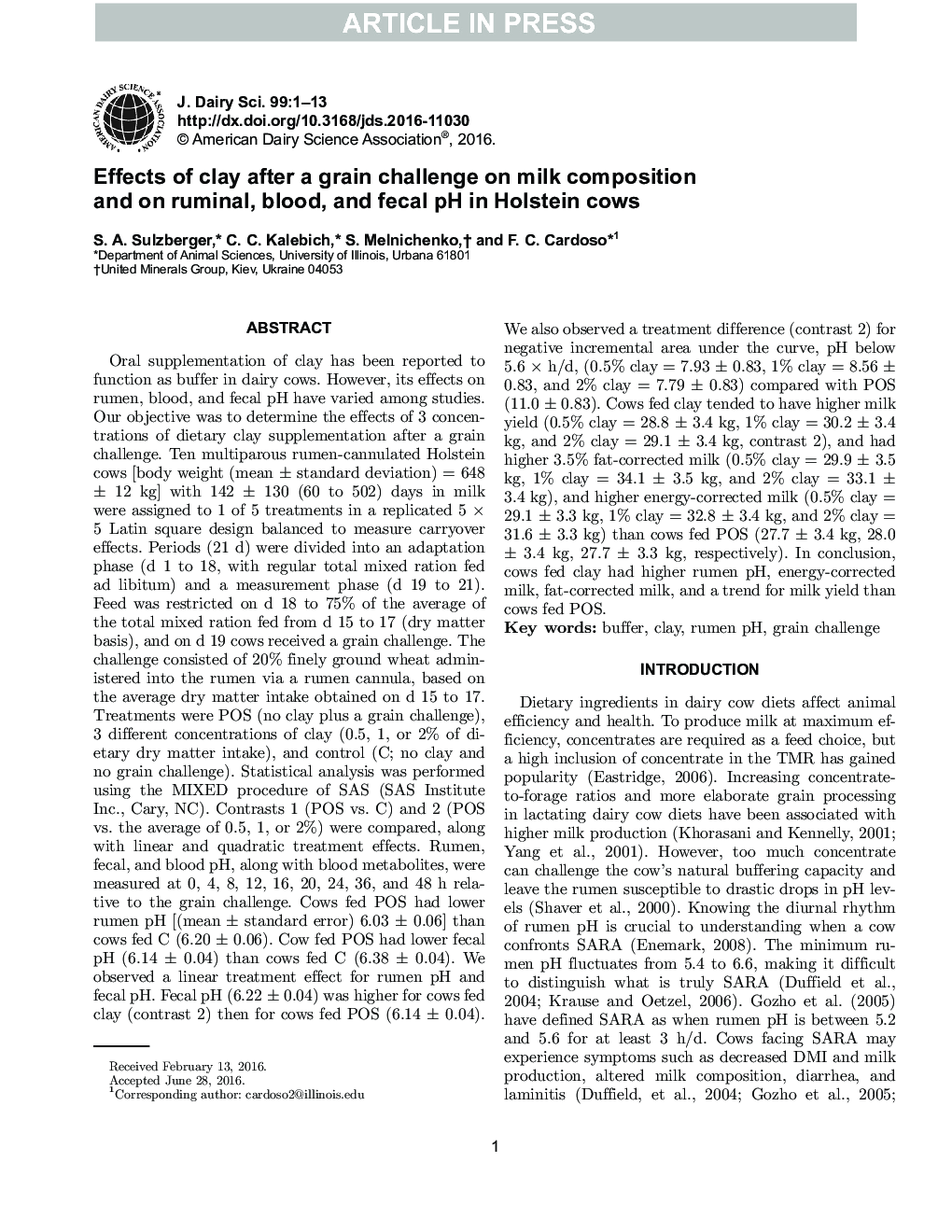| کد مقاله | کد نشریه | سال انتشار | مقاله انگلیسی | نسخه تمام متن |
|---|---|---|---|---|
| 5541837 | 1402511 | 2016 | 13 صفحه PDF | دانلود رایگان |
عنوان انگلیسی مقاله ISI
Effects of clay after a grain challenge on milk composition and on ruminal, blood, and fecal pH in Holstein cows
دانلود مقاله + سفارش ترجمه
دانلود مقاله ISI انگلیسی
رایگان برای ایرانیان
کلمات کلیدی
موضوعات مرتبط
علوم زیستی و بیوفناوری
علوم کشاورزی و بیولوژیک
علوم دامی و جانورشناسی
پیش نمایش صفحه اول مقاله

چکیده انگلیسی
Oral supplementation of clay has been reported to function as buffer in dairy cows. However, its effects on rumen, blood, and fecal pH have varied among studies. Our objective was to determine the effects of 3 concentrations of dietary clay supplementation after a grain challenge. Ten multiparous rumen-cannulated Holstein cows [body weight (mean ± standard deviation) = 648 ± 12 kg] with 142 ± 130 (60 to 502) days in milk were assigned to 1 of 5 treatments in a replicated 5 Ã 5 Latin square design balanced to measure carryover effects. Periods (21 d) were divided into an adaptation phase (d 1 to 18, with regular total mixed ration fed ad libitum) and a measurement phase (d 19 to 21). Feed was restricted on d 18 to 75% of the average of the total mixed ration fed from d 15 to 17 (dry matter basis), and on d 19 cows received a grain challenge. The challenge consisted of 20% finely ground wheat administered into the rumen via a rumen cannula, based on the average dry matter intake obtained on d 15 to 17. Treatments were POS (no clay plus a grain challenge), 3 different concentrations of clay (0.5, 1, or 2% of dietary dry matter intake), and control (C; no clay and no grain challenge). Statistical analysis was performed using the MIXED procedure of SAS (SAS Institute Inc., Cary, NC). Contrasts 1 (POS vs. C) and 2 (POS vs. the average of 0.5, 1, or 2%) were compared, along with linear and quadratic treatment effects. Rumen, fecal, and blood pH, along with blood metabolites, were measured at 0, 4, 8, 12, 16, 20, 24, 36, and 48 h relative to the grain challenge. Cows fed POS had lower rumen pH [(mean ± standard error) 6.03 ± 0.06] than cows fed C (6.20 ± 0.06). Cow fed POS had lower fecal pH (6.14 ± 0.04) than cows fed C (6.38 ± 0.04). We observed a linear treatment effect for rumen pH and fecal pH. Fecal pH (6.22 ± 0.04) was higher for cows fed clay (contrast 2) then for cows fed POS (6.14 ± 0.04). We also observed a treatment difference (contrast 2) for negative incremental area under the curve, pH below 5.6 à h/d, (0.5% clay = 7.93 ± 0.83, 1% clay = 8.56 ± 0.83, and 2% clay = 7.79 ± 0.83) compared with POS (11.0 ± 0.83). Cows fed clay tended to have higher milk yield (0.5% clay = 28.8 ± 3.4 kg, 1% clay = 30.2 ± 3.4 kg, and 2% clay = 29.1 ± 3.4 kg, contrast 2), and had higher 3.5% fat-corrected milk (0.5% clay = 29.9 ± 3.5 kg, 1% clay = 34.1 ± 3.5 kg, and 2% clay = 33.1 ± 3.4 kg), and higher energy-corrected milk (0.5% clay = 29.1 ± 3.3 kg, 1% clay = 32.8 ± 3.4 kg, and 2% clay = 31.6 ± 3.3 kg) than cows fed POS (27.7 ± 3.4 kg, 28.0 ± 3.4 kg, 27.7 ± 3.3 kg, respectively). In conclusion, cows fed clay had higher rumen pH, energy-corrected milk, fat-corrected milk, and a trend for milk yield than cows fed POS.
ناشر
Database: Elsevier - ScienceDirect (ساینس دایرکت)
Journal: Journal of Dairy Science - Volume 99, Issue 10, October 2016, Pages 8028-8040
Journal: Journal of Dairy Science - Volume 99, Issue 10, October 2016, Pages 8028-8040
نویسندگان
S.A. Sulzberger, C.C. Kalebich, S. Melnichenko, F.C. Cardoso,